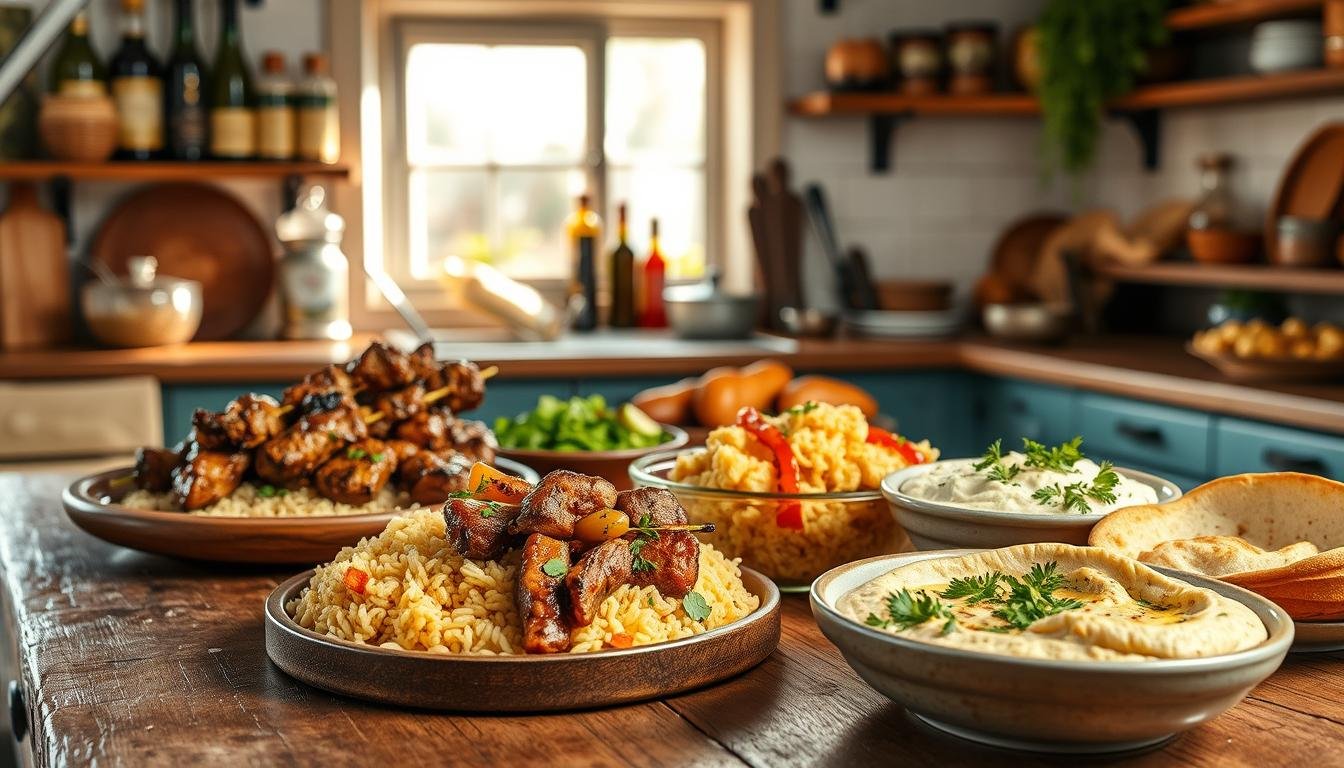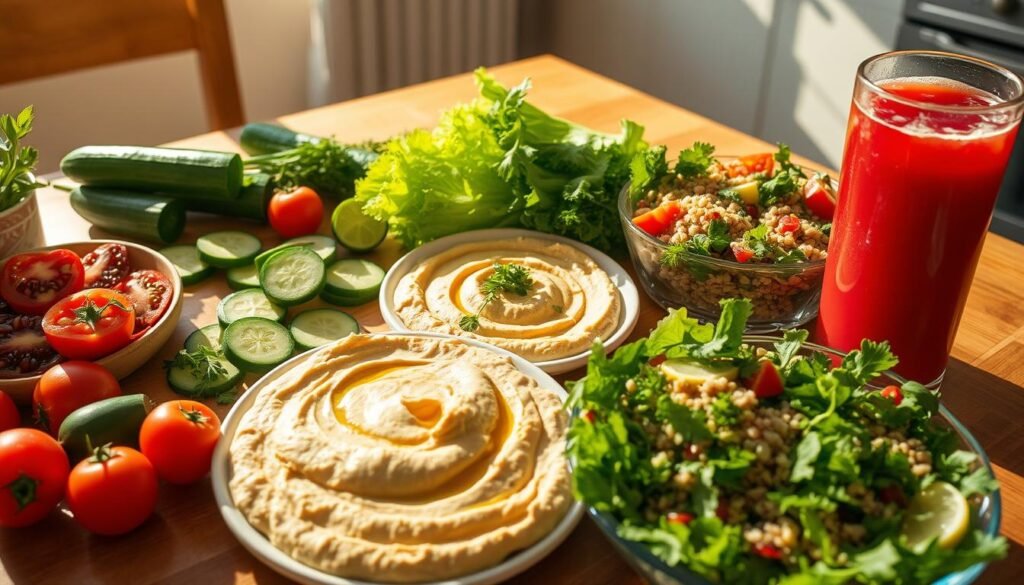Best Lebanese Food Recipes for Home Cooks

Have you ever tasted a meal that took you far away? That’s what Lebanese cuisine did for me. The mix of fresh ingredients, bold flavors, and deep history is magical. It feels like Lebanon is in your kitchen! This journey is not just about food. It’s about making unforgettable memories with family and friends.
Cooking Lebanese food at home is not only doable; it’s easy if you know how. Imagine garlic cooking and lemon being squeezed. Picture herbs mixing in a bowl. This brings traditional Lebanese comfort food to your table. Cooking becomes fun with these simple Lebanese food tips. Let’s start this tasty adventure together. Sahtain—enjoy your meal!
Key Takeaways
- Discover the magic of Lebanese cuisine at home with fresh, vibrant ingredients.
- Traditional Lebanese comfort food can transform your home dining experience.
- Easy Lebanese food prep can make cooking a joyous adventure.
- Embrace simple methods to recreate authentic Lebanese dishes.
- Create heartwarming memories with loved ones through flavorful meals.
Introduction to Lebanese Cuisine
Welcome to the vibrant world of Lebanese cuisine! It’s a place where both new cooks and seasoned chefs find joy. Lebanese dishes bring families together with the smell of garlic, lemon, and olive oil. It’s like magic!
Lebanese food mixes many flavors and cultural influences, with a history of thousands of years. So, why not start a culinary journey? It will bring your family closer with tasty meals and snacks.
The Rich History of Lebanese Food
Lebanese cuisine has grown over centuries, mixing Phoenician, Ottoman, and French influences. New ingredients, cooking methods, and recipes came with each culture. They created what we enjoy today. Sharing meals is a key part of Lebanese culture, perfect for family times.
Key Ingredients in Lebanese Cooking
The heart of Lebanese food is using fresh, high-quality ingredients. Basics like garlic, lemon, and olive oil are not just tasty but healthy too. Herbs like parsley, mint, and cilantro add more flavors. And let’s not forget tasty snacks like falafel and kibbeh. They are great additions to any meal.
Popular Lebanese Dishes to Try at Home
Lebanese cooking offers tasty dishes that are also simple to prepare. Let’s explore some popular ones to make in your kitchen. They’ll bring Lebanon’s rich tastes to you!
Hummus: The Classic Starter
Everyone enjoys hummus. This dip is a must in Lebanese food. It goes great with veggies or pita chips. Making it is easy, needing only chickpeas, tahini, lemon, and garlic.
Tabouleh: A Fresh Herb Salad
Tabouleh is a zesty herb salad. It’s full of parsley, mint, and bulgur. As a side or a light meal, it shines. The herb-lemon dressing pairs well with any dish.
Chicken Shawarma: A Flavorful Feast
Trying chicken shawarma brings street food vibes home. This dish uses spicy, yogurt-marinated chicken. Cook it till it’s just right. Enjoy it in pita bread with garlic sauce or with tabouleh.

Vegetarian Lebanese Recipes
Diving into vegetarian Lebanese food is like exploring a world full of bold and cozy flavors! It’s perfect for gatherings or a healthy meal. Let’s check out three amazing dishes from Lebanese cuisine.
Mutabbal: Smoky Eggplant Dip
Mutabbal is a top choice in vegetarian Lebanese food. This creamy dip mixes roasted eggplant with tahini, garlic, and lemon. It’s great with warm pita bread and a favorite at gatherings!
Falafel: Crispy Chickpea Balls
Falafel has a crunchy outside that everyone loves. Made from chickpeas, herbs, and spices, these balls are fried until golden. They’re tasty by themselves or with hummus or tahini sauce!
Lentil Soup: A Nutritious Choice
Lentil soup is truly comforting. It’s a mix of lentils, veggies, and spices. This nutritious soup is a key part of vegetarian Lebanese food. Try it once, and you’ll want more!
Grains and Sides in Lebanese Cooking
Lebanese cuisine shines with grains and bread. They match well with many dishes and add special tastes and textures. Explore Lebanese rice dishes like the fluffy Rice Pilaf and enjoy the soft warmth of fresh bread.
Rice Pilaf: The Perfect Accompaniment
Lebanese Rice Pilaf is cherished, serving as a base for various flavors and textures. It’s made with long-grain rice, vermicelli, and spices, transforming meals into something special. The simple yet flavorful dish absorbs tastes from foods it’s paired with, making it a Lebanese meal staple.

Lebanese Bread: A Staple for Every Meal
Freshly baked bread is a key part of Lebanese meals. It wraps around meat and veggies, scoops up dips like hummus, or eaten by itself. Its soft, fluffy texture makes every meal comforting. It’s great for dipping into sauces and juices from your plate, too.
Cooking Techniques Unique to Lebanese Cuisine
Learn the rich tastes of Lebanese cuisine at home by learning age-old techniques. These methods mix cooking with storytelling and heritage in every meal. Explore the incredible world of Lebanese cooking with us!

Grilling: The Key to Authentic Flavors
Grilling plays a big role in Lebanese food, bringing out flavors that are unmatched. Imagine sizzling kebabs and tender meats. First, marinate your meat or veggies in spices and olive oil. Then, cook them over a fire. This brings out the deep, smoky flavors that are key to Lebanese meals. Who knew Lebanese cooking could be so simple?
Baking Traditional Pastries: A Step-by-Step Guide
Baking is a gateway to sweet and savory Lebanese treats. Begin with staples like baklava or sfouf. These treats usually have layers of dough with a nut-spice mix inside. The secret is in taking your time and being exact. Carefully mix the dough and add just the right amount of filling. Baking these lets you bring a taste of Lebanon home.
Here’s a guide comparing two popular pastries:
| Pastry | Main Ingredients | Flavor Profile |
|---|---|---|
| Baklava | Phyllo dough, nuts, honey | Sweet, nutty |
| Sfouf | Semolina, turmeric, pine nuts | Slightly sweet, earthy |
Spices and Seasonings in Lebanese Dishes
Lebanese cuisine is known for its amazing flavors. The secret is classic Lebanese spice mixes. These mixes make ordinary ingredients taste incredible.

Understanding Za’atar and Its Uses
Za’atar is a key spice mix in Lebanese cooking. It is made of thyme, sesame seeds, and sumac. This blend adds a tangy, herby taste to many dishes.
I love to sprinkle za’atar on warm Lebanese bread. Or mix it with olive oil for a tasty dip. It’s amazing how this simple mix can make dishes taste so good.
The Role of Sumac in Lebanese Cooking
Sumac is a must-have in Lebanese cooking. It’s a reddish-purple spice that adds a tangy, lemony flavor. I often add it to salads like fattoush and it’s great on roasted veggies or meats.
Sumac brings a unique, citrusy touch to Lebanese food. It truly makes dishes stand out with its flavor.
Desserts to Satisfy Your Sweet Tooth
Diving into Lebanese sweets and desserts is an adventure! Think of the nutty layers of baklava or the sweet maamoul cookies. These treats make meals complete. Let’s dig into these delicious delights together!
Baklava: A Sweet, Nutty Delight
Picture thin, crispy layers of pastry filled with nuts and sweet syrup. That’s baklava. It often has rosewater or orange blossom, making it wonderfully fragrant. And its glossy, golden top is so tempting!

Maamoul: Stuffed Cookies for Special Occasions
Lebanese sweets and desserts include the beloved maamoul. Filled with dates, pistachios, or walnuts, these cookies are a treat. Made for celebrations, they’re dusted with sugar and full of joy. Whether shaped by molds or hands, their rich taste is incredible.
| Lebenese Desserts | Main Ingredients | Unique Flavor |
|---|---|---|
| Baklava | Filo pastry, nuts, syrup | Rosewater or orange blossom |
| Maamoul | Shortbread, dates, nuts | Powdered sugar |
How to Host a Lebanese Dinner Party
Planning a Lebanese dinner party is about more than food. It’s about creating an experience that celebrates Lebanese culture. You’ll need to think about the menu and how to set your table. I’ll show you how to make your party a success!
Creating a Balanced Menu
For a Lebanese dinner party, start with a variety of appetizers like hummus, mutabbal, and tabouleh. These starters kick off the feast. Then, serve main dishes such as chicken shawarma, grilled kofta, and vegetarian stuffed grape leaves.
Include sides like rice pilaf and Lebanese bread. End with desserts such as baklava and maamoul.
Tips for Table Settings and Presentation
Start with a clean tablecloth for a welcoming setting. Add Lebanese elements like ceramic plates, colorful napkins, and fancy dishes. Use candles and flowers to create a warm atmosphere.
Arrange the food nicely on platters. Garnish with fresh herbs or sumac for a pretty look. Your goal is to make your guests feel like they are in Lebanon with every bite!

Encourage your guests to enjoy the food. Tell them the stories behind the dishes for more fun. Hosting a Lebanese dinner party is about making connections and having joy. These thoughtful touches make it special.
Health Benefits of Lebanese Ingredients
Lebanese food tastes amazing and is good for you too. Adding fresh Lebanese produce to your meals makes you healthier. We’ll look at the nutritional benefits of some important ingredients.
Fresh Herbs and Their Nutritional Value
Lebanese cooking loves fresh herbs like parsley, mint, and cilantro. These aren’t just tasty; they’re super healthy! For instance, parsley is full of vitamins A, C, and K, boosting your immune system. Mint helps with your digestion.
And cilantro helps clean your body of toxins. Eating these herbs is a big part of healthy Lebanese eating.
The Advantages of Using Olive Oil

Olive oil is a big deal in Lebanese food for its health perks. It’s got monounsaturated fats, which are good for your heart; they lower bad cholesterol. It’s also full of antioxidants to fight inflammation. Adding olive oil makes your food taste better and keeps you healthy, Lebanese style.
Now, let’s compare the nutrition in some Lebanese herbs:
| Herb | Vitamin A | Vitamin C | Vitamin K |
|---|---|---|---|
| Parsley | 84% | 77% | 574% |
| Mint | 52% | 37% | 13% |
| Cilantro | 27% | 8% | 109% |
By choosing fresh Lebanese produce, you get tasty meals full of important vitamins and minerals. Let every meal celebrate good health!
Pairing Lebanese Food with Beverages
Choosing the right drink to go with your Lebanese meal is key. It can make the dining experience much better. Whether you have lebanese yogurt-based dishes or lighter meals, the perfect drink will make the flavors pop. This makes your meal unforgettable.

Traditional Lebanese Wines to Explore
Lebanon has been making wine for thousands of years. Now, it has wineries that make top-notch wines. With famous ones like Château Ksara and upcoming ones like Domaine des Tourelles, their wines are rich in taste. Imagine enjoying a full-bodied red wine with a light lebanese dinner. It’s the best!
Refreshing Drinks: Ayran and Mint Lemonade
Ayran is a great non-alcoholic choice. This salty yogurt drink is wonderful with lebanese yogurt meals. You can easily make it by mixing yogurt, water, and a little salt. For those who want a zesty drink, mint lemonade is perfect. It matches well with light Lebanese meals, adding a fresh zest that’s just right.
Common Mistakes to Avoid When Cooking Lebanese Food
Cooking Lebanese food is fun, but some mistakes can happen. Knowing these errors helps your dishes shine! Here are key tips for delicious Lebanese lunches and meals.
Overlooking Fresh Ingredients
Lebanese food loves fresh ingredients! Think fresh herbs, tomatoes, and cucumbers. You should avoid dried herbs or store-bought salads. Your meals will taste better!

Always choose fresh for amazing flavor and health benefits. It’s good to support local farmers too. Fresh stuff makes meals special, whether it’s a quick lunch or big dinner.
Skipping Marination: Why It Matters
Marinating brings out flavors in Lebanese dishes. Without it, food may taste bland. For example, marinate chicken for shawarma in spices, garlic, and yogurt overnight.
Marination makes meat tender for kebabs and kafta. It turns a simple meal into something amazing. Next time, marinate well. You’ll love the results in the taste!
Conclusion: Embracing Lebanese Cuisine at Home
We’ve reached the end of our journey through Lebanese cuisine. It’s a world full of exciting dishes. No matter if you’re new to cooking or already a pro, trying these dishes is fun. Foods like hummus, chicken shawarma, and baklava let you taste Lebanon’s spirit.
Lebanese cooking is great because it’s so flexible. You can prepare meals ahead or find simple cooking tricks. Your kitchen can become a place full of Middle Eastern tastes. Keep trying new things and master skills like grilling and making pastries. This will make your meals truly Lebanese.
Bringing Lebanese food into your home means more than cooking. It’s about loving the process and the flavors and traditions behind it. So, put on your apron, try new recipes, and fill your home with Lebanon’s wonderful smells. This will not just make your food better. It will also bring a piece of another culture into your daily life!